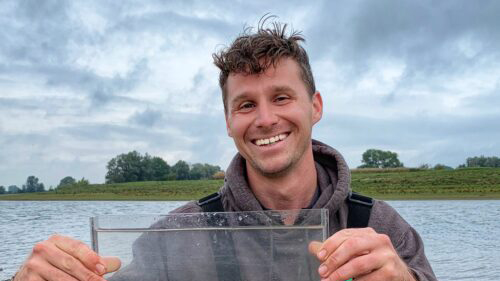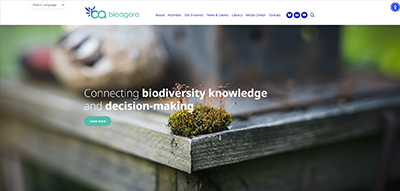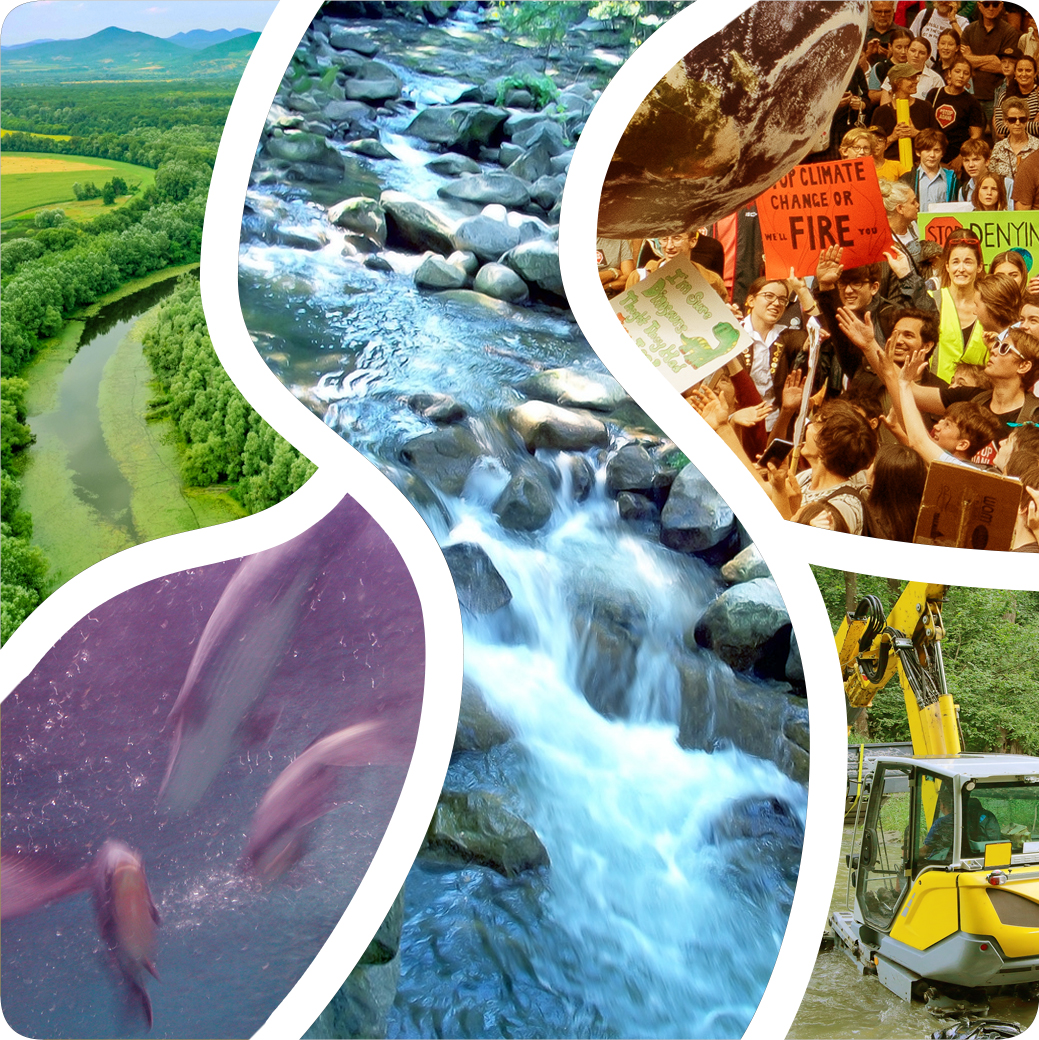Dr Twan Stoffers
Postdoctoral researcher fish ecology
Leibniz Institute of Freshwater Ecology and Inland Fisheries & Aquaculture & Fisheries group at Wageningen University and Research
Scientists & Researchers

My Projects
 BioAgora - Connecting biodiversity knowledge
BioAgora - Connecting biodiversity knowledge
and decision-making
 Optimising river floodplain restoration for fishes: a large-scale evaluation in the river Rhine
Optimising river floodplain restoration for fishes: a large-scale evaluation in the river Rhine
- Key project facts
- Over the past three decades, more than 50 river-floodplain restoration projects have been implemented in the lower river Rhine, improving water quality and creating new habitats. However, the expected recovery of rheophilic (flow-loving) fish species has lagged behind.
- To investigate the nursery function of rehabilitated floodplains for riverine fish, Rijkswaterstaat initiated a large-scale comparative study in 2017.
- Ecological consultancies ATKB and Bureau Waardenburg conducted juvenile fish community and habitat surveys at over 60 floodplains and groyne fields between 2017 and 2020.
- Each site was sampled annually in July, using seine netting or electrofishing, depending on habitat type. Key environmental variables such as water quality, flow, physical structures, and substratum type were mapped and measured.
- The study aimed to assess how juvenile fish distribution relates to habitat characteristics, assuming that higher numbers and diversity of rheophilic juveniles indicate better nursery habitat quality.
- Findings are intended to guide further improvements to floodplain areas to better support specialised fish communities in the river Rhine.
- What impact did these projects have on biodiversity, if any?
The river-floodplain restoration projects in the lower river Rhine led to clear improvements in fish biodiversity, although results varied between sites. Overall, restoration increased the abundance and richness of fish species, particularly generalists and limnophilic species. However, the recovery of rheophilic (flow-loving) species, which are important indicators of river health, was slower and often incomplete.
The large-scale study showed that fish biodiversity improved most in floodplains with permanent connectivity to the river and high habitat heterogeneity. Sites with a range of habitats, such as shallow vegetated zones and flowing side channels, supported richer fish communities. In contrast, projects with poor connectivity or limited habitat complexity showed weaker results. In short, while restoration increased overall fish biodiversity, fully supporting the recovery of specialised rheophilic species requires not just reconnection, but also the restoration of flow dynamics, habitat diversity, and good water quality.
- What work challenges did you face and what approach did you take to solve them?
One of the main challenges was coordinating such a large-scale project and ensuring that data collection across many sites was consistent and comparable. To address this, I maintained clear and regular communication with all collaborators, emphasising the importance of standardised methods and accurate data for informing future restoration efforts. I provided detailed protocols and guidance to ensure everyone understood the scientific and practical value of the work.
- What lessons learned are transferable to other places/projects?
I learned that clear protocols, early alignment on methods, and consistent communication are essential for large, multi-site ecological studies. Investing time up front in standardising data collection, training collaborators, and setting shared goals greatly improves data quality and project efficiency. These lessons are transferable to any large-scale restoration, monitoring, or conservation project where multiple teams or locations are involved.
- What is your biggest barrier and what are you trying to do about it?
The biggest technical barrier was managing and analysing the large and complex database after data collection. Handling data from over 60 sites with different habitat types and fish communities made it challenging to organise the information consistently and extract meaningful patterns. To address this, I spent considerable time cleaning, structuring, and validating the data. I also developed clear analysis strategies, step-by-step workflows, and used robust statistical methods to make sure the results were reliable and could inform restoration efforts effectively.
My Focus and Approach
- Lessons Learnt - Some recommendations for others?
- What’s most important:
Always stay focused on the ecological goals, making sure that restoration really benefits biodiversity, especially target species like riverine fishes.
- Do this, not that:
Do: Communicate clearly and consistently with all collaborators.
Not: Assume that everyone understands the project goals and methods the same way without checking. - Always start by:
Building a shared understanding of objectives, methods, and expectations across the project team before any technical work begins.
- What to do when things get difficult…:
Take a step back, reassess the goals, and talk openly with the team. Most challenges can be solved by breaking them into smaller tasks and setting clear priorities.
- 5 simple steps to:
- Define clear goals for what fish species and habitats you want to support.
- Collect standardised field data on fish communities and habitat features.
- Map and categorise habitat types and connectivity.
- Analyse habitat use and fish distribution patterns.
- Translate findings into practical, site-specific restoration recommendations.
- The biggest barrier and what I am trying to do about it:
Managing and analysing large, complex datasets was my biggest barrier. I addressed this by investing time early on in setting up clear data structures, good metadata documentation, and consistent collaboration with data managers and statisticians.
- What’s most important:
My Journey
- My journey:
My interest in aquatic ecosystems and fish ecology began at a young age, driven by the work of Jacques Cousteau and the mesmerising BBC documentaries with David Attenborough. These early influences created in me a deep fascination with underwater life and the complex interactions that occur within ecosystems. Growing up, I took advantage of every opportunity to learn more about the aquatic world, particularly by scuba diving, angling, and catching animals in the pond. This passion naturally led to a deep interest in aquatic ecosystems, in particular marine fishes and sharks. Despite their critical ecological role, I realised that marine fish and sharks are often misunderstood and underappreciated due to the public’s unfamiliarity with their environment and the misconceptions surrounding them.
As I learnt more about global environmental issues, I became more and more concerned about the growing threats to marine and freshwater ecosystems, such as pollution, overfishing, anthropogenic modifications, and habitat degradation and fragmentation. These human-caused threats have far-reaching implications for aquatic biodiversity, particularly for large and migratory fish species that rely on connected habitats to complete their life cycles. My academic career has been shaped by the need to address these threats through restoration and conservation science, with a special emphasis on the role of habitat heterogeneity and connectivity in supporting marine and freshwater fish populations, as well as assessing the spatiotemporal dynamics of river ecosystems. Understanding the spatiotemporal dynamics of river ecosystems is critical for global biodiversity restoration, as many restoration efforts overlook the complex ecological needs of fish at various life stages and on larger spatial and temporal scales. This oversight undermines the long-term viability of conservation efforts.
- My Education:
-
I completed my PhD in Fish Ecology and Biodiversity at Wageningen University & Research between July 2017 and December 2022. My research focused on how restored floodplains in the Netherlands function as nursery areas for riverine fish. I managed and coordinated large-scale fieldwork campaigns, led data collection and analysis, and produced scientific papers and reports. My work covered topics such as fish ecology, biodiversity, floodplain dynamics, habitat modelling, and food web interactions.
Before my PhD, I obtained a Master of Science in Marine Biology at Wageningen University & Research (2011–2014), graduating with a grade of 8.0. During my MSc, I studied the management of coastal and marine systems, including the effects of fishing, recreation, and urbanisation on biodiversity. I developed strong skills in fisheries ecology, ecomorphology, and the life history of aquatic organisms, and was actively involved in student counselling and open days.
I started my academic journey with a Bachelor of Science in Biology (specialisation in Human and Animal Health Biology) at Wageningen University & Research (2008–2011), graduating with a grade of 8.0. During my BSc, I was actively involved in the study association Biologica, further strengthening my foundation in biological sciences.
-
- The Big Change:
My work has helped shift the understanding and practice of river restoration in the Netherlands and across Europe towards a stronger ecological foundation. Through my PhD and postdoctoral research, I showed how restored floodplains can better support fish biodiversity when habitat heterogeneity and connectivity are prioritised. These insights have shaped recommendations for improving river restoration strategies in the lower Rhine and other European rivers. By linking field ecology with practical restoration advice and policy engagement, my work has strengthened the science-policy interface and contributed to national and European strategies like the EU Biodiversity Strategy 2030 and the Nature Restoration Law. Overall, my research and outreach are helping to drive more resilient, biodiversity-friendly river management in the Netherlands and beyond.
- Favourite part of the work I do:
My favourite part of my work is connecting ecological research with real-world restoration and conservation efforts. I enjoy studying how fish use river habitats, understanding their behaviour and needs, and then translating that knowledge into practical advice that can make a real difference for river health and biodiversity.
Interview
Key Topics:
Key Topics
These relate to specific topics (e.g. technical solutions; restoration activities etc.) addressed within the showcase materials.
- Floodplain restoration
- Ecological evaluation
- Monitoring
- Fish conservation
Prone2Success Factors Demonstrated:
Prone2Success Factors Demonstrated
These are the Prone2Success checklist factors which are highlighted within this showcase. More information on the Prone2Success checklist can be found here.
- Supports WFD, NRL and other restoration policy goals
- Communicate/engage with stakeholders from the outset
- Obtain sufficient finance for all project stages
- Demonstrate specific ecological improvements/legal compliance / communicating results during and after the project
NRL Restoration Categories:
NRL Restoration Categories
These are the restoration categories (listed under Annex VII of the European Nature Restoration Law (NRL) which are relevant to this showcase.
- [5] Re-establish river meandering
- [6] Remove obsolete barriers
- [7] Re-naturalise river beds
- [12] Assist migration of provenances and species
- [22] Improve connectivity across habitats
- [26] Restore fish spawning / nursery areas
Was this information useful?
No
Thank you for submitting feedback.
Click here to share your thoughts
Resources
Projects:
 BioAgora - Connecting biodiversity knowledge
BioAgora - Connecting biodiversity knowledge
and decision-making
 Optimising river floodplain restoration for fishes: a large-scale evaluation in the river Rhine
Optimising river floodplain restoration for fishes: a large-scale evaluation in the river Rhine
Articles:
- Belletti, B., de Leaniz, C.G., Jones, J., Bizzi, S., Börger, L., Segura, G., Castelletti, A., Van de Bund, W., Aarestrup, K. & Barry, J. (2020) More than one million barriers fragment Europe’s rivers. Nature, 558888,, 436-441.
- Bernhardt, E.S. & Palmer, M.A. (2011) River restoration: the fuzzy logic of repairing reaches to reverse catchment scale degradation. Ecological Applications, 2211,, 1926-1931.
- Buijse, A.D., Coops, H., Staras, M., Jans, L., Van Geest, G., Grift, R., Ibelings, B.W., Oosterberg, W. & Roozen, F.C. (2002) Restoration strategies for river floodplains along large lowland rivers in Europe. Freshwater biology, 4477,, 889-907.
- Erős, T., Olden, J.D., Schick, R.S., Schmera, D. & Fortin, M.-J. (2012) Characterizing connectivity relationships in freshwaters using patch-based graphs. Landscape ecology, 2277,, 303-317.
- Palmer, M.A., Menninger, H.L. & Bernhardt, E. (2010) River restoration, habitat heterogeneity and biodiversity: a failure of theory or practice? Freshwater biology, 5555,, 205-222.
- Schlosser, I.J. (1991) Stream fish ecology: a landscape perspective. Bioscience, 4411,, 704-712.
- Ward, C., Tockner, K. & Schiemer, F. (1999) Biodiversity of floodplain river ecosystems: ecotones and connectivity. Regulated Rivers: Research & Management, 1155,, 125-139.
- Wohl, E., Lane, S.N. & Wilcox, A.C. (2015) The science and practice of river restoration. Water Resources Research, 51, 5974- 5997.
- Wolter, C., Buijse, A. & Parasiewicz, P. (2016) Temporal and spatial patterns of fish response to hydromorphological processes. River Research and Applications, 32, 190-201.
Peer reviewed papers:
- Stoffers, T., Collas, F. P. L., Buijse, A. D., Geerling, G. W., Jans, L. H., Van Kessel, N., ... & Nagelkerke, L. A. J. (2021). 30 years of large river restoration: How long do restored floodplain channels remain suitable for targeted rheophilic fishes in the lower river Rhine?. Science of the Total Environment, 755, 142931.
- Stoffers, T., Buijse, A. D., Geerling, G. W., Jans, L. H., Schoor, M. M., Poos, J. J., ... & Nagelkerke, L. A. J. (2022). Freshwater fish biodiversity restoration in floodplain rivers requires connectivity and habitat heterogeneity at multiple spatial scales. Science of the Total Environment, 838, 156509.
- Stoffers, T., Buijse, A. D., Verreth, J. A., & Nagelkerke, L. A. (2022). Environmental requirements and heterogeneity of rheophilic fish nursery habitats in European lowland rivers: Current insights and future challenges. Fish and Fisheries, 23(1), 162-182.
Acknowledgements & Links
This material was provided by: Twan Stoffers
For more information, see https://bioagora.eu/
I am grateful to Rijkswaterstaat, the national water authority of the Netherlands, and the EU Interreg project Green Blue Rhine Alliance project for providing financial support for this study. This study would not have been possible without enormous field sampling effort of many people throughout the years.


